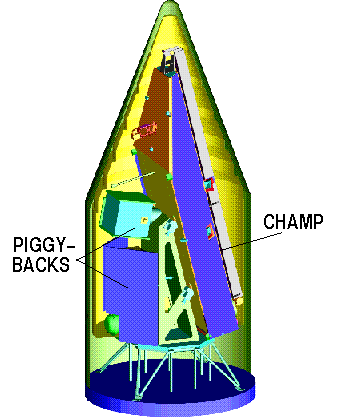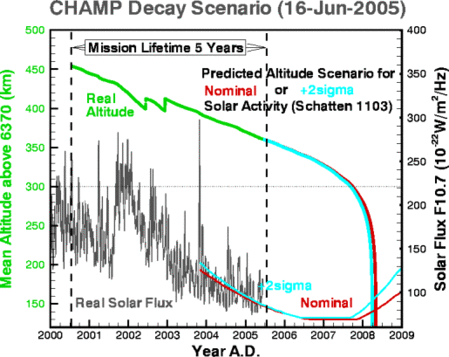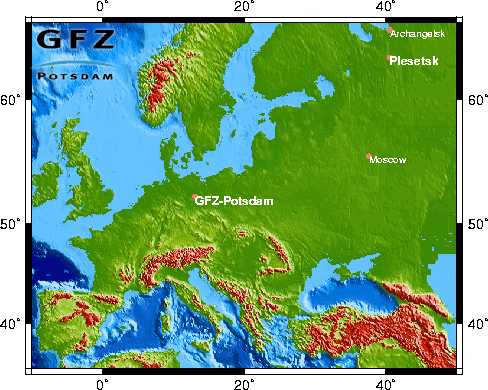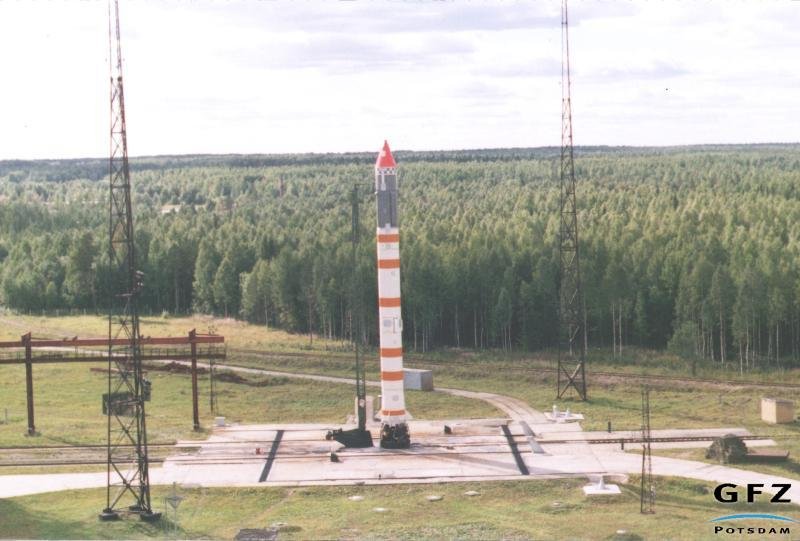Orbit Characteristics
The CHAMP satellite was launched with a Russian COSMOS launch vehicle on July 15, 2000 into an almost circular, near polar (i = 87°) orbit with an initial altitude of 454 km. The design lifetime of the satellite system is 5 years. The 87 degree inclination is the maximum inclination which can be served from the Plesetsk cosmodrome.
The reason for choosing an almost circular and near-polar orbit is the advantage of getting a homogeneous and complete global coverage of the Earth's sphere with orbit and magnetometer measurements, being important to resolve the gravitational and magnetic geopotentials. An advantage of the 87° orbit vs. a dawn-dusk sun-synchronous orbit is the local time variation of the satellite's ground track which is essential for all three scientific applications in order to enable the separation of constituents of periodic phenomena like tides and day-night variations.
An initial altitude of about 454 km was chosen
- to guarantee a multi-year mission duration even under severe solar activity conditions,
- to account for the requirement imposed by the atmosphere/ionosphere application to look from the outside through the different atmospheric layers, i.e., an even higher altitude would be the optimum in this regard, and
- because 454 km is the adequate altitude to observe the Earth's magnetic main field. From the gravity field's point of view an even lower initial altitude would be desirable.
Due to atmospheric drag the altitude will decrease over the mission lifetime. As CHAMP passed through the solar activity maximum around 2002, the predicted natural decay depends on the magnitude of the actual solar activity cycle and may amount to more than 200 km or only 50 km within the 5 years. Therefore at least one velocity change manoeuvre by the 40 mN thrusters cold gas was foreseen, correcting for orbit injection errors and rising or lowering the orbit of the S/C to guarantee a 5 years observation period above 300 km and some months of observation time below 300 km altitude towards the end of the mission.
After 2 orbit changes in 2002, CHAMP raised up again in 2006 in higher altitude and provided highly valuable data until September 2010.
The International Laser Ranging Service (ILRS at ilrs.gsfc.nasa.gov) provided tracking from its global network of laser ranging stations to support the project.
COSMOS Launch Vehicle
The POLYOT Design Bureau, Omsk has manufactured the Cosmos launch vehicle for about 40 years.
The two-stage booster burns unsymmetrical dimethyl hydrazine (UDMH) as a fuel and either nitric acid or nitrogen tetroxide (N2O4) as the oxidiser. The first stage employs two 11 D614 (RD216) main engines, while the second stage relies on a single, restartable 11D49 main engine. The second stage also carries an independent propulsion system for coast and spacecraft deployment operations. Used only for low earth orbit missions, the Cosmos-3M has a demonstrated payload capacity of 1,500 kg to a low altitude, 51° inclination parking orbit. However, since 1988 all Cosmos-3M missions have originated from the Plesetsk Cosmodrome with inclinations of 66°, 74°, 83°, 87° and SSO.

Main characteristics of the COSMOS launch system:
- Launch facility: ground supported, stationary
- Total launch mass: 109 metric tons
- Payload mass: up to 1500kg
- Payload orbits: 250 to 1700km
- Total length of launcher: 32.4m
- Core diameter: 2.4m
- Launches: >700
- Success Rate: 97.4%
Injection Orbit
The CHAMP spacecraft (S/C) was launched on July 15, 2000 at 11:59:59.628 UTC (i.e. 16:00:00:00. Plesetsk local time) into an almost circular orbit The ascend trajectory events for the COSMOS launcher carried the CHAMP S/C with two piggybacks (the Italian MITA and the German/Russian RUBIN) into an orbit of about 454 km altitude and an inclination of about 87.3° are approximately at:
State Vector for CHAMP
- epoch = 2000/08/01 00:00:00 GPS
- Brouwer mean elements in Conventional Inertial System (CIS)
- semi mayor axis = 6823.287km
- eccentricity = 0.004001
- inclination = 87.277°
- argument of perigee = 257.706°
- right ascension of the ascending node = 144.210°
- mean anomaly = 63.816°
- This leads to
- true period = 93.55 min
- rev/day = 15.40
- nodal period = 966 days
- perigee period = 93 days







